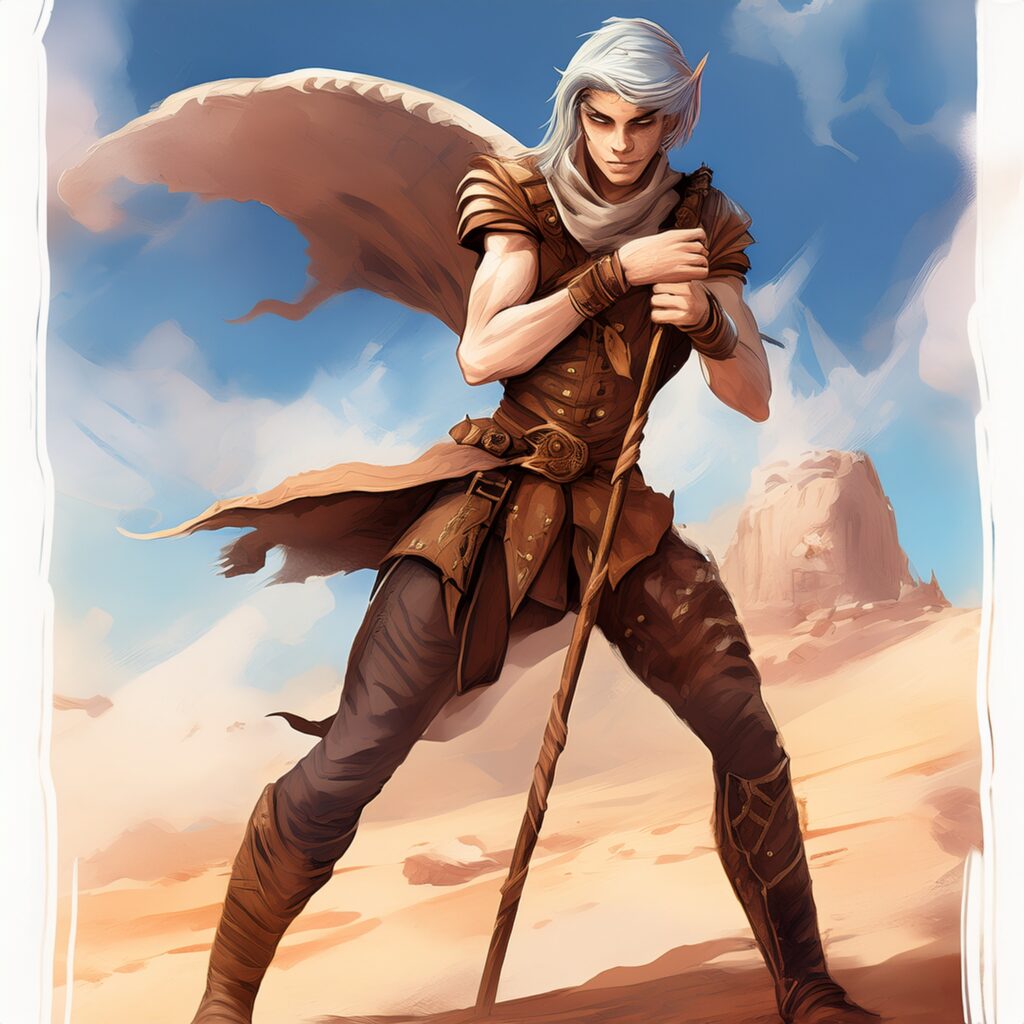Half-Elf

The elves of Athas may have an instinctive distrust of outsiders, but they must still deal with them from time to time. As so often happens in the wilds and in the cities, sometimes the two find common ground. In the case of humans, whether through shared passions or less fortunate circumstance, children of mixed heritage are born into the world: the half-elves.
Personality: Half-elves are notorious loners. Many Athasians believe that half-elves combine the worst traits of both races, but the most difficult aspect of half- elves – their lack of self-confidence – comes not from their mixed origins but rather from a life of rejection from both parent races. Half-elves try in vain to gain the respect of humans or elves. This constant quest for meaning defines the half-elf.
Many half-elves learn at an early age to get along with everyone, defusing hostility and finding common ground. As a race, they have elven grace without the elven tribal insularity and human energy without the human need to dominate and control. They often make excellent ambassadors and go-betweens (except between elves and humans, since each side suspects the half-elf of favouring the other).
Half-elves know that character is often less a product of race than of life experience. As such, they are often open to friendships and alliances with other races, and less likely than most to rely on first impressions when forming opinions of new acquaintances.
Physical: To humans, half-elves look like elves, and to elves, they look human. Averaging over six feet tall, half-elves combine elven dexterity with human resilience. Bulkier than elves and not as lean as the desert runners, most half-elves find it easier to pass themselves off as full humans than as full elves, but all have some features that hint at their elven heritage.
Half-elf men can have facial hair and sometimes grow beards to mask their elven ancestry. Half-elven colouration and features lie somewhere between their human and elf parents, and thus show a variety even more pronounced than that found among either race.
Relations: Elves have no tolerance for mixed children. Elven tradition demands that children born from the union of elf and human be left for lirrs and other predators, and some tribes even drive out mothers of such children. A half-elf born in a city has a greater chance to survive; still, life is not easy for half-elves.
Half-elves sometimes find friendship among muls or even thri-kreen and cooperate with companions when necessary, but find it difficult to rely on anyone. Many turn to the animal world for company, training creatures to be servants and friends. The survival skills and animal affinity that half-elves developed to cope with isolation make them valuable beast handlers in human society.
Lands: Despite their unique nature, half-elves don’t form communities. The few half-elves that settle down tend to live among humans who, unlike elves, at least find a use for them. Half-elves have no lands of their own, though they are welcome in human cities. They are less welcome in elven tribes, where they struggle to keep up with natural elven speed.
Some half-elves avoid company altogether, visiting civilisation only rarely. Others, in contrast, throw themselves into the thick of society, putting their charisma and social skills to use in diplomatic roles or as swindlers.
Language: Half-elves learn the languages of whatever community they grew up in, which usually includes the common tongue. It is not unusual for half-elves to be unable to speak elven, especially if they were cast out from their parent’s tribe.
Half-Elf Society: Unlike other races, half-elves do not consider themselves a separate race, and, with very few exceptions, do not try to form half-elven communities. A half-elf’s life is typically harder than either a human’s or an elf’s. It is difficult for half-elves to find acceptance within either elven or human society. Many half-elves choose the life of a loner or an exile over the inevitable rejection that comes with trying to fit in. Half-elves are forced to develop a high level of self-reliance. Most half-elves take great pride in their self-reliance, but this pride often makes half-elves seem aloof to others. For many half-elves, the detachment is a defensive mechanism to deal with a desire for acceptance from either human or elven society that will likely never come.
Role-playing Suggestions: Desperate for the approval of either elves or humans, you are even more desperate to appear independent, to cover your desire for approval. As a result, you tend towards a sullen self-reliance, refusing favours. You take every opportunity to show off your skills in front of elves and humans, but if an elf or a human were to actually praise you, you would probably react awkwardly. From your childhood, your closest friendships have been with animals. Other half-elves do not interest you.
As time goes by and you learn from experience, you will find you can also get along with other races that are neither human nor elven. You don’t feel the terrible need for their approval, and yet they give it more readily.
The following game statistics apply to the half-elf
Half-Elf Racial Traits
+2 to One Ability Score: Half-elf characters get a +2 bonus to one ability score of their choice at creation to represent their varied nature.
Medium: Half-elves are Medium creatures and have no bonuses or penalties due to their size.
Normal Speed: Half-elves have a base speed of 30 feet.
Low-Light Vision: Half-elves can see twice as far as humans in conditions of dim light.
Adaptability: Half-elves receive Skill Focus as a bonus feat at 1st level.
Elf Blood: Half-elves count as both elves and humans for any effect related to race.
Elven Immunities: Half-elves are immune to magic sleep effects and get a +2 racial bonus on saving throws against enchantment spells and effects.
Keen Senses: Half-elves receive a +2 racial bonus on Perception checks.
Multitalented: Half-elves choose two favored classes at 1st level and gain 1 additional hit point or skill point whenever they take a level in either one of those classes.
Languages: Half-elves begin play speaking Common and Elven. Half-elves with high Intelligence scores can choose any languages they want (except secret languages, such as Druidic).
Animal Companion: At 5th level, a half-elf can form a close bond with an animal companion. This animal is a loyal companion that accompanies the Half-Elf on his adventures as appropriate for its kind.
This ability functions like the druid animal companion ability (which is part of the Nature Bond class feature), except that the Half-Elf’s effective druid level is equal to his character level – 4
This companion is in addition to any other companion the Half-Elf my have.
